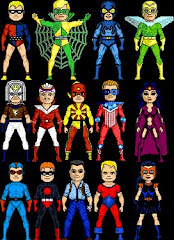courtesy of http://dcanimated.wikia.com/wiki/Question
The
Question was a
superhero and a member of the
Justice League after the
Thanagarian invasion. He was known for his "crackpot"
[2] conspiracy theories and brilliant deductive skills. He used a special flesh-colored mask that covered his face, along with a special yellow gas
[3][4] could change the colors of his hair and clothing. The Question was possibly the most unconventional superhero ever to join the organization. He was a paranoid investigator who, by his own admission, shamelessly went through everyone's trash,
[3] drove a car with no license plates,
[1][5] and believed there was an ominous conspiracy inherent to everything.
History
Assignments
The Question assisted
Supergirl and
Green Arrow in uncovering the truth behind Supergirl's eerie dreams, leading him to
Galatea, her evil clone. Although his teammates regard him as a nut for his over the top theories, such as the connections between boy bands and global warming, and the Girl Scouts and the crop circle phenomenon, the fact is that the Question delivers results. Therefore,
Batman appointed him to find a link between
Cadmus and Lex Luthor.
[3]
Flourishing Romance
While the Question was investigating, the
Huntress approached him offering information on Cadmus, if he would help her track down
Steven Mandragora, the man who killed her parents. Even though the Question knew she had nothing on the mysterious organization, he played along, simply because he was fond of the Huntress. The Question is incredibly perceptive, and he most likely investigated the background of every Leaguer, seeing as he knew everything about the Huntress before they met. After the Question dissuaded her from murdering Mandragora in front of his son, the Huntress took a liking to him, and they started dating.
[1]
Cadmus
With the help of the Huntress, the Question stole
high-security files from a Cadmus terminal, in hopes of finding their link to
Luthor. After cracking the files, he gained access to several classified information, namely
Amanda Waller's simulations and everything about the
Justice Lords. When the Question saw the security tape of
Superman killing President Lex Luthor in the parallel universe,
[6] he became convinced that those events were predestined to happen in his own reality, considering the events that led up to that fateful moment, were also already unfolding. The Question saw how Waller's simulations predicted that a war between the Justice League and the government would result in Armageddon. So, he confronted
Superman, who, in spite of assuring they would never fight the government, didn't reassure a much disturbed Question. So, he headed off to LexCorp, where he was determined to kill Luthor in order to prevent Superman from doing so. Seeing as he was a "well-known crackpot", the Question believed that his actions wouldn't affect the League's reputation, and was willing to commit that sacrifice to guarantee Superman's untainted legacy. However, he was thwarted by Luthor, who mysteriously exhibited superhuman strength and easily knocked him around. The Question was then taken under Cadmus custody, where
Dr. Moon tortured him for the location of the stolen files.
[2]
He was finally rescued by Superman and the Huntress, who carried him out of the facilityafter a fight with Captain Atom. He was teleported to the
Watchtower, where he recuperated with the Huntress on his side.
[4] Shortly after, when the
Ultimen invaded the Watchtower, the Question mustered enough strength to knock out one
Juice clone with a bedpan, promptly saving his love, the Huntress.
[7]
After full recovery, the Question kept going out with the Huntress and resumed his pursuit to uncover conspiracies. His latest discovery was that Baskin-Robbins has, not 31, but 32 flavors,
[8] contrary to general beliefs. Then Question answered the world-wide call to the entire Justice League when
Darkseid invaded Earth, and managed to run over a few
Parademons with his car.
[5]
Abilities and Equipment
Despite possessing no special powers or gadgets, the Question was a skilled martial artist,
[1][3] endowed with brilliant deductive skills and a genius intellect. He was also very skilled in the intimidation and interrogation of criminals, on par with Batman. His intimidation skills were derived from, at least in part, his featureless mask, which could be quite scary to an average person.
[3]
He always saw the clue everyone overlooked, and solved the conundrums he set himself out to investigate. The Question was always very suspicious of everything, and his inquisitive mind earned him a reputation of being paranoid and eccentric. Aside from his distinctive "faceless" mask and classic GTO, the Question used no notable equipment.
 While never achieving animated fame, at least one member of the Mighty Crusaders did reach a modest level of priminence in another medium. Which seemed to be a harbinger of a revival two decades later in the form of "Radio Comics", predecessor to Mighty/Red Circle Comics.
While never achieving animated fame, at least one member of the Mighty Crusaders did reach a modest level of priminence in another medium. Which seemed to be a harbinger of a revival two decades later in the form of "Radio Comics", predecessor to Mighty/Red Circle Comics.
































